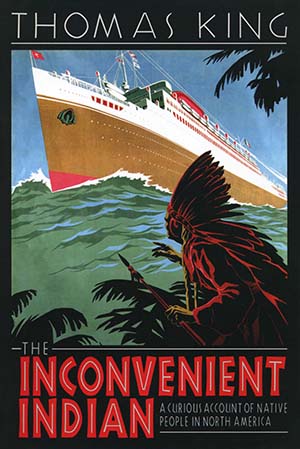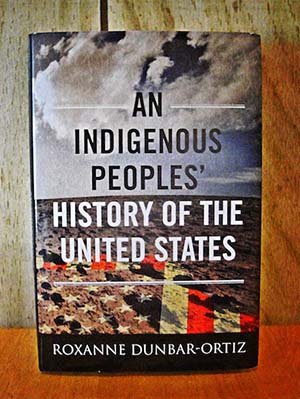by Robert Caldwell
October 27, 2014
The Inconvenient Indian:
A Curious Account of Native People in North America
By Thomas King.
Minneapolis: University of Minnesota Press,
2012, 287 pages, $24.95.
An Indigenous Peoples’ History of the United States
By Roxanne Dunbar-Ortiz
Boston: Beacon Press, 2014, 296 pages, $27.95.
Two new books, Thomas King’s The Inconvenient Indian and Roxanne Dunbar-Ortiz’s An Indigenous Peoples’ History of the United States, offer American Indian perspectives on the history of North America.

Award-winning novelist King boldly ignores the colonizers’ boundaries that he traverses in daily life to take on both Canada and the United States, offering compelling conversations and vignettes that fuse to form an alternative, story-based account of the past. Historian Dunbar-Ortiz takes a different approach, an historical synthesis that challenges mainstream history of the United States head-on, providing ruthless critique and call for a total re-conceptualization of U.S. history.
The Inconvenient Indian in many ways follows an indigenous oral tradition narrative. The book details historical relations between white culture and indigenous peoples in North America. King, who was born in the United States but lives in Canada, notes that many tribes’ territories spanned the present-day border. He observes differences in law and tradition between the two countries, but is not limited by the geographical boundaries.
This book, which is virtually unknown in the United States outside of Native American Studies, has been a Canadian bestseller. In early 2014, it won the prestigious National Award for Canadian Non-Fiction and the RBC Taylor Prize.
King’s stories offer a circular rather than linear form of history; the book is not chronological in sequence. It is about the past (and present) but doesn’t attempt to be a history book. King telescopes between details and generalities with more attention to engaging the reader than offering empirical precision. The book has no footnotes and doesn’t pretend to be authoritative or exhaustive. The author is happy to offer anecdotes from his personal experience with a huge dose of humor.
Dead, Live, and Legal
King writes of three kinds of Indians: dead, live, and legal. Dead Indians are what many North Americans imagine when they hear Indian. Live Indians are frustrating because they work on a construction site, in the professions, or like King, the university.
But the most frustrating Indians are legal ones with land claims, treaties, and organized into indigenous governments:
“The Legal Indian was one of those errors in judgment that North America made and has been trying to correct for the past 150 years.”
Of course, all live Indians aren’t “legal.” In the United States, only enrolled citizens of federally recognized tribes” are legal, and in Canada, “status Indians” fit this category. But these “legal Indians” represent only a fraction of the actual indigenous people in North America. The legal framework that created them was and is part of a divide-and-conquer strategy created in the 19th century by the U.S. and Canadian governments.
King relates that overall blood quantum often determines access to U.S. Bureau of Indian Affairs programs, and while marriages between members of two different tribes are common, their children might still lack blood quantum requirements to be a citizen of either of their parents’ tribes.
In addition to the author’s compelling policy arguments, the book critically examines a number of popular but damaging stereotypes. It offers ample examples of the double standards in cultural expectations set for white people versus First Nations peoples.
One such example revolves around the use/abuse of alcohol: “In North America, White drunks tend to be invisible, whereas people of color who drink to excess are not. In fact, White drunks can be amusing… Dean Martin, Red Skelton, W.C. Fields, John Wayne, Paris Hilton, Britney Spears, …Winston Churchill, Boris Yeltsin, George Bush, Daniel Patrick Moynihan” are noteworthy examples. (187)
King’s method and style is what he calls “a series of conversations and arguments” that he has been having with himself and others most of his adult life” that “draws more on storytelling techniques than historiography,” but the book is “fraught with history.” (xii)
King makes important observation about history, such as “most of us think that history is the past. It’s not. History is the stories we tell about the past.” History is not neutral or benign. (2-3) He reminds us that one of history’s grand maxims, “you can’t judge the past by the present,” is both convenient and specious. “Perhaps,” he says, “it is unfair to judge the past by the present, but it is also necessary.” (265)
Critical History

Roxanne Dunbar-Ortiz’s An Indigenous Peoples’ History of the United States focuses almost exclusively on the North American territory claimed by the United States (although her first chapter includes a brief introduction to various “indigenous high cultures” of Mexico).
Dunbar-Ortiz is a feminist, revolutionary and historian. She grew up in rural Oklahoma, daughter of a sharecropper and half-Indian mother. The stories of her paternal grandfather, a white settler, farmer and veterinarian who had been a Socialist Party member and labor activist with the Industrial Workers of the World in Oklahoma in the first decades of 20th century, inspired her to a lifelong commitment to activism.
She married and moved to San Francisco at the age of 18, and attended San Francisco State College, eventually completing a doctorate in history at UCLA. She has been furthering the fields of Native American Studies and Ethnic Studies and been active with the American Indian Movement (AIM) and the International Indian Treaty Council since the early 1970s.
Her first published book, The Great Sioux Nation: An Oral History of the Sioux Nation and its Struggle for Sovereignty, was published in 1977. That was followed by Roots of Resistance: A History of Land Tenure in New Mexico, 1680-1980 and Indians of the Americas: Human Rights and Self-Determination.
More recently she has published Red Dirt: Growing up Okie, memoirs of her early life, Outlaw Woman, a memoir of her antiwar and radical activism of the 1960s and ’70s, and Blood on the Border: A Memoir of the Contra War, which chronicles U.S.-sponsored terror inflicted on the people of Nicaragua following the 1979 revolution and 1981 election of the left-wing Sandinista government.
The highly engaging An Indigenous Peoples’ History of the United States is NOT an attempt to tell the history of the many indigenous nations who have lived within what is now claimed by the United States, but rather a critical history of the U.S. from an indigenous perspective.
While the book is a history, it connects seamlessly to present struggles in Indian Country. At just over 200 pages of text for the body of the book, organized into eleven chapters, it is quite digestible. Dunbar-Ortiz is to be commended in that unlike many other books of its kind, the book considers class relations both historically and in contemporary society.
The book displays exemplary politics, drawing heavily from postcolonial studies, explaining class, dependency theory, comprador class, and genocide both theoretically and in historical context. Ortiz also offers a new periodization for U.S. history overall, as well as one for the genocide waged against American Indians: The Jacksonian Era, California Gold Rush, Post-Civil War “Indian Wars,” and the 1950s Termination Period. Her explanation of genocide makes the important point that genocide is often incorrectly reduced to mean disappearance.
No synthesis of this scope could offer minute detail, there are but some important omissions, especially when the details run counter to Ortiz’s main assertion.
While she does explain the phenomenon of slave-owning and pro-Confederate elites from the “Five Civilized Tribes,” she doesn’t mention the contribution of certain tribes who acted as foot-soldiers to the Anglo-American genocide.
Sometimes she fails to explain historical fracturing of tribes. She seems to confuse the Seminole Nation of Oklahoma, removed after the so-called Seminole Wars, and the Seminole Tribe of Florida, comprised of descendants of those Seminoles who continued to live in the Everglades after the period of Indian Removal. She writes: “…much later (in 1957) the U.S. government designated them an ‘Indian Tribe.’ The Seminoles were one of the “Five Civilized Tribes ordered to Indian Territory.” (101)
Some inaccuracies in the advance copy are more glaring. Puerto Ricans would disagree with her assertion that Columbus never “set foot on any territory ever claimed by the United States.” Lastly, when discussing land, territory, and reservations, she erroneously conflates the number of Federally Acknowledged Tribes with “Indigenous groups.” (11)
Despite these concerns, An Indigenous Peoples’ History of the United States should be on everyone’s fall reading list.
Destroying Myths
Both books are well-written and engaging. Those in literary circles will be more likely to read King’s The Inconvenient Indian, while historians are more likely to come across Dunbar-Ortiz’s An Indigenous Peoples’ History of the United States, but these two books complement each other nicely.
On the whole, American Indians and First Nation people know a lot more about European culture and colonial history of North America than white North Americans know about indigenous culture.
One need not look further than the volume of writing on the Washington Redskins controversy to see how clueless some people are about the brutality of the Euro-American colonial project. And after reading these books, one cannot but conclude that for Natives, the colonial era is now.
Robert Caldwell is a member of Solidarity in Texas. He is a member of the Choctaw-Apache tribe of Ebarb.
